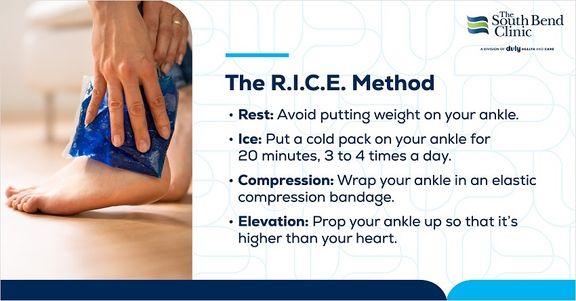Almost everyone has had a sore ankle at some point. But if it’s ever gotten to the point where it starts to hurt, you know that ankle pain is, well, a pain. In addition to hurting, it can make moving around difficult or even keep you off your feet entirely for a while.
While there are many potential causes of ankle pain, two of the most well-known are sprains and breaks. These two injuries share some similarities, but they are very different from one another.
If you’ve hurt your ankle and you suspect a sprain or a fracture, you might have some questions. Which one is it? What type of provider can help?
Here are answers to common questions about the difference between ankle sprains and fractures and what you can do after an injury.
What’s the Difference Between a Sprain and a Fracture?
The key difference is the part of the ankle that’s injured. An ankle sprain occurs when a ligament – tissue that connects your bones – gets stretched or torn. The ankle bones stay intact.
Fracture is another word for break. When you fracture your ankle, there’s a break in one or more of the three ankle bones: the fibula (outer bone of your lower leg), tibia (shinbone), or talus (a bone at the back of your foot).
What Are Stress Fractures?
When people say they broke their ankle, they often mean they had a traumatic fracture. This is when the break occurs suddenly, as a result of a specific injury or incident.
Ankle stress fractures are a little different. They are small breaks or severe bruising within the bone that are caused by overuse or repetitive activity that puts too much stress on the ankle.
Are Fractures Worse Than Sprains?
A broken bone might sound worse than a sprain, but it’s not that simple. Sprains can be just as painful and, like fractures, can make it difficult to bear weight.
Recovery depends on the severity of the injury. Fractures take about six weeks to heal. If you need surgery on more than one ankle bone, it could take up to two years to get back to normal. Minor sprains often take as little as two weeks to heal, but severe ones can take up to 12 weeks.
Also read: Facts About Bones: What’s Your Bone IQ?
How Can I Tell if It’s a Sprain or a Fracture?
It’s not always easy to tell if you have a sprain or a fracture since they have similar symptoms. If your ankle looks deformed or bones appear to be popping out, it’s likely a fracture. But if swelling is the only visible symptom, it could be either.
A sprain won’t show up on an X‑ray, since X‑rays produce images of bones rather than ligaments. An X‑ray is used to rule out a fracture, rather than to find a sprain.
Learn about imaging procedures.
Are Ankle Sprains and Fractures Treated the Same Way?
Overall, treatment is different for the two injuries.
Sprains don’t always require medical care. If you don’t have severe pain, you can start with the R.I.C.E. method.

In most cases, you can manage pain with over-the-counter medications, like ibuprofen (Advil), naproxen sodium (Aleve), or acetaminophen (Tylenol).
Fractures, on the other hand, always require some degree of medical care to heal. For small breaks or stress fractures, you probably won’t need surgery. Your provider may recommend wearing a cast, brace, or walking boot that supports your ankle as you walk. They may also do a procedure called closed reduction, where they reposition broken bones without making any cuts.
In more severe cases or if bones have been moved out of place, you might require surgery. After performing an open reduction, the surgeon will secure the pieces of your broken bones and hold them in place with rods, screws, or other fasteners (internal fixation).
What Type of Provider Should I See?
It depends on the type and severity of your injury.
For a sprain, you might not need to see a provider at all. If the pain and swelling don’t get better with self-care, or if you’re having trouble walking, schedule an appointment with your provider.
If you have a severe sprain, you suspect a fractured ankle, or you’re not sure which type of injury you have, it’s best to get immediate or emergency care. Be on the lookout for signs that you need care right away:
- Severe pain or swelling, especially if it starts right after an injury
- Inability to put weight on your foot
- Symptoms of an infection, such as changes in skin color or a fever over 100 degrees Fahrenheit
- An open wound or one where the bone is sticking out
- A visibly deformed ankle
- Pain that doesn’t go away and keeps getting worse
In some cases, you may need specialty care. For example, you may need to see an orthopedist (provider who specializes in bone care) or an orthopedic surgeon for a severe injury. You might also need to work with a physical therapist or sports medicine provider to regain strength and help your ankle heal.
Also read: Knowing Where to Go for Care: The South Bend Clinic Immediate Care Centers
I Don’t Have a Sprain or Fracture. What Else Could Be Causing My Ankle Pain?
Ankle pain doesn’t just stem from a sprain or a fracture. Other possible causes include:
- Ankle strain (an injury to muscles and tendons)
- Plantar fasciitis
- A broken foot
- Rupture of the Achilles tendon
- Gout
- Tendonitis
- Arthritis
Don’t let ankle pain keep you sidelined any longer. Getting the right care quickly can make all the difference in your recovery time and long-term mobility. If you’re experiencing severe pain, swelling, or can’t put weight on your ankle, visit a South Bend Clinic Immediate Care Center today. The current wait times for our Immediate Care locations are available online. Our experienced providers can assess your injury and provide immediate treatment with no appointment needed.
For persistent ankle issues or advanced treatment needs, schedule an appointment with one of our orthopedic specialists. They provide comprehensive evaluation, advanced imaging, and personalized treatment plans to get you back to the activities you love. Take action now and give your ankles the expert care they deserve.
Health Topics:




